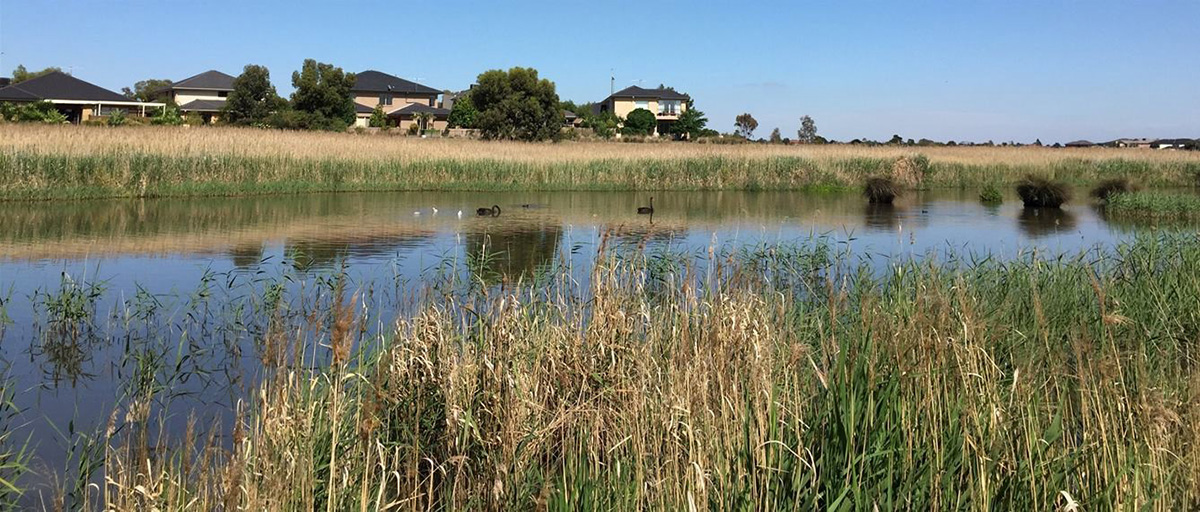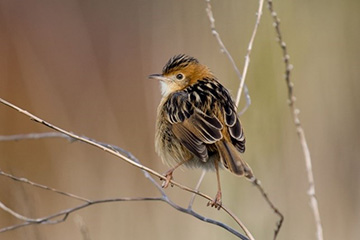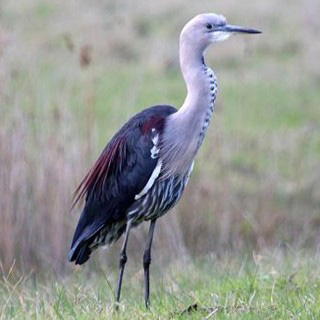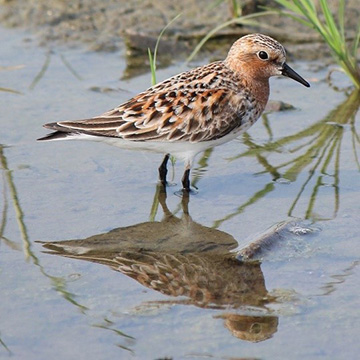Tom Parkinson's monthly column, introducing the diverse range of flora and fauna on show at Sanctuary Lakes.
Last Spring, I took a stroll around Skeleton Creek with a couple of its Friends, Denice and John. Being Spring the Flora was sensational and I wrote about the Coastal Flax Lilies, the Correa Rock, the ubiquitous Water Reeds and the magnificent stands of Black Wattle. This Easter I decided to walk the full circuit of the Creek starting at Breezewater reserve via Seabrook to Point Cook Road on the south side and then cross the road bridge to the Altona Meadows northern side and take its full length of the now pavemented walkway to the Cheetham Wetland Bridge. Then following the footpath on the Sanctuary Lakes south side of the Creek, back to Breezewater. The circuit has been further enhanced on the Altona Meadows side by nine new information boards illustrated by Sanctuary Lakes’ resident ornithologist Bob Winter’s brilliant photographs.

The key aim of Nature’s Rubik is to regularly diarise, the effects on a large area of coastal land, teeming with Flora and Fauna, by the arrival over seventeen years, of 3,000 houses, 10,000 residents and a Golf Course. The daily intercourse between the Flora, Fauna and the Residents plays like a Soap Opera. The successes, the failures, the winners and losers, are an unending daily drama. A walk around Skeleton Creek personifies the performance. Bob Winter calculates over a 110 bird species regularly visit and live in or by the Creek, alongside a minimum of 500 varieties of Flora. On this circuit of the Creek, I am going to look at two of the smallest birds and one of the largest; all have great character backgrounds and perfect for type casting within the unfolding drama.
 Bob Winter’s wonderful photo of the Golden Headed Cisticola (Cisticolidae) A small flock of the diminutive Golden Headed Cisticolas have made their home in the Creek’s Water Reeds, quietly and almost inconspicuously feeding on ground insects taken from beneath the tall reeds and by eating the reed’s seeds, assisting in its germination. Cisticolas often remain hidden, but their presence is easily betrayed by their very distinctive loud buzzing and whistling calls. Once this call is heard, it is often relatively easy to see a Golden Head perched atop of a reed’s stalk.
Bob Winter’s wonderful photo of the Golden Headed Cisticola (Cisticolidae) A small flock of the diminutive Golden Headed Cisticolas have made their home in the Creek’s Water Reeds, quietly and almost inconspicuously feeding on ground insects taken from beneath the tall reeds and by eating the reed’s seeds, assisting in its germination. Cisticolas often remain hidden, but their presence is easily betrayed by their very distinctive loud buzzing and whistling calls. Once this call is heard, it is often relatively easy to see a Golden Head perched atop of a reed’s stalk.
This amazing little Bird is often called the Tailor Bird due to its ability, using stolen spider’s web threads, to sew leaves together on the outer surface of its rounded nest. A nest with a side entrance near the top, filled with fine grasses, plant down and spiders' web. Both the male and female help in nest-building although the female incubates the four to six eggs on her own.
In our Rubik soap opera, the Golden Headed Cisticolas would be cast as the shy but busy little sweetheart.
Now for dramatic contrast we go from one of the Creek’s smallest to one of its largest and toughest birds, the White-necked Heron.
 The White-necked Heron (Ardea pacifica) The White-necked Heron is a large bird that can grow to over 110 centimetres. Head and neck are white with dark grey bill. Its back and wings are a sooty black with a bluish sheen. Prominent white patch at the shoulder of the wing seem as "headlights" in flight. Breast and belly are grey-brown, streaked white. Legs dark grey. Non-breeding individuals have dark spots down the throat; these may wear away. Neck spots on juveniles spread to the side of the neck. Breeding individuals lack the spots and have maroon plumes on the upper body.
The White-necked Heron (Ardea pacifica) The White-necked Heron is a large bird that can grow to over 110 centimetres. Head and neck are white with dark grey bill. Its back and wings are a sooty black with a bluish sheen. Prominent white patch at the shoulder of the wing seem as "headlights" in flight. Breast and belly are grey-brown, streaked white. Legs dark grey. Non-breeding individuals have dark spots down the throat; these may wear away. Neck spots on juveniles spread to the side of the neck. Breeding individuals lack the spots and have maroon plumes on the upper body.
Like most water birds, the populations of the White-necked are known to be nomadic, moving from one water source to another often entering habitats they have not previously occupied. Taking advantage of flooding and heavy rain where the surplus of food allows them to breed and raise their young. Presently there are a pair in the Sanctuary Lakes area and I spotted them by the Creek’s foot bridge searching the shallows for their enormously varied and wide diet of freshwater mussels, fish, shrimp, yabbies, spiders, dragonfly nymphs, praying mantis, grasshoppers, water beetles, lizards, and even young ducklings. Actually, if it’s in the shallows and it moves the White-neck will probably eat it.
There is no certainty that the pair are breeding, but if they are their nest will a platform of sticks in a tree some 30 metres above the ground.
Up to six eggs are laid. Both parents incubate the eggs and feed the young by regurgitation. Parents continuously guard the nest and young for three or four weeks. Older siblings harass the smaller chicks, which usually die; generally, two chicks are produced. The young, fledge after six to seven weeks.
The White-neck Heron is definitely cast as the no nonsense tough guy.
Finally, in complete contrast, our little adventurer. Can you imagine something that weighs less than a box of matches flying around the world once a year? Well that is exactly what our Creek and Sanctuary Lake summer resident the Red-neck Stint does.
 The Red-necked Stint (Calidris ruficollis) The Red-neck is one of the smallest waders, it measures around 15cm and weighs 35-45 gm just a little larger in size and weight than a sparrow. It is a migratory sandpiper breeding in Siberia and west Alaska and then it follows the East Asian-Australasian Flyway moving to non-breeding areas in Australasia south. They arrive into our district from late August to September and leave from early March to mid-April. First-year birds normally remain in Australia for first summer/winter. A small flock of ten plus Red-neck primers can be seen near the Cheetham end of the Skeleton Creek foraging in the salt marsh and shallow wetlands. They are omnivorous, taking seeds, insects, small vertebrates, plants in saltmarshes, molluscs and crustaceans. They are easy to recognise even at a distance, as they forage in a very distinctive manner, taking a rather hunched posture, picking constantly and rapidly at the muddy surface, then dashing to another spot and start jabbing again.
The Red-necked Stint (Calidris ruficollis) The Red-neck is one of the smallest waders, it measures around 15cm and weighs 35-45 gm just a little larger in size and weight than a sparrow. It is a migratory sandpiper breeding in Siberia and west Alaska and then it follows the East Asian-Australasian Flyway moving to non-breeding areas in Australasia south. They arrive into our district from late August to September and leave from early March to mid-April. First-year birds normally remain in Australia for first summer/winter. A small flock of ten plus Red-neck primers can be seen near the Cheetham end of the Skeleton Creek foraging in the salt marsh and shallow wetlands. They are omnivorous, taking seeds, insects, small vertebrates, plants in saltmarshes, molluscs and crustaceans. They are easy to recognise even at a distance, as they forage in a very distinctive manner, taking a rather hunched posture, picking constantly and rapidly at the muddy surface, then dashing to another spot and start jabbing again.
The little Red-neck could be seen as symbolic of the Rubik drama. Their survival is affected by human population growth and economic development that is destroying their major migratory stopover wetlands with pollution and habitation. Severe weather changes of climate can also affect the birds: being blown off course can deplete their energy supplies, and they may then die of exhaustion.
A circuit of Skeleton Creek will not only be good for your well-being, but allows you to view in close up, the spectacular, on-going, multi-episode drama, that is being written, directed and produced by nature itself.